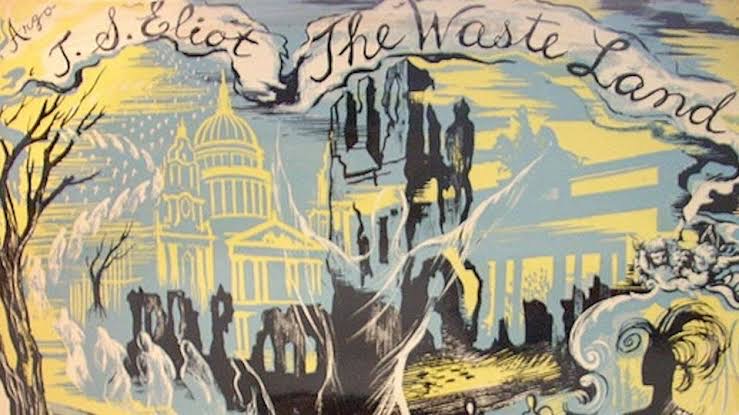TABLE OF CONTENT
The WASTE LAND: SUMMARY AND THEMES
SUMMARY:

T.S. was born on 26 September 1888 and died on 4 January 1965. He was a poet, essayist, playwright, literary critic, and editor. T. S. Eliot wrote a poem titled The Waste Land, which is recognized as one of the most significant poems of the 20th century and an essential piece of modernist poetry. The poem stands out for its new approach, which combines several creative styles and structures. Eliot also references other parts of literature, such as the Bible, Shakespeare, Hindu, and Buddhist writings. The Waste Land could be understood as poetry about breakage or grief, and Eliot’s repeated connections regarding the First World War show that conflict had an important role in setting about its sociological, mental, and spiritual downfall. The poem is divided into 5 sections and each section has its importance and significance.
This poem has different themes including death, rebirth, social document, spirituality, materialism, frustration, lust, the human psyche, brokenness, and isolation.
The speaker of the poem declares at the opening of the poem that spring is a terrible season and that it is harsh. He claims that springtime brings back broken dreams and recollections of the past. This period of the year plays a crucial role in remembering past events and grievous recollections. The piece then switches to a woman named Marie's distinct upbringing memory. The picture of decaying, twisted trees and unsuitable grounds for farming is then given.

Unexpectedly, you find yourself in a room with Madame Sosostris, a "clairvoyant" or metaphysical medium who tells you your future. As though that weren't sufficient, you next witness a crowd of individuals "walking zombie-like" across London Bridge. They are moving together seamlessly.
We enter the glittering, vast room of rich, irresponsible women in "A Game of Chess," part 2. A woman is surrounded by artwork, jewelry, and fragrances, as well as a portrait depicting a mythological figure from antiquity. A painting of "the change of Philomel," a Greek mythological figure who has been seduced by King Tereus and later transformed into a nightingale, hangs in her bedroom. Throughout their talk, a woman urges the man for specifics regarding his ideas and experiences. She suggests playing a game of chess after receiving none and descending into a state of hopelessness. The scene then shifts to a bar scene with two women interacting The discussion focuses on one female's attempt at convincing another one to get her teeth fixed in time for her partner's arrival from the battlefield. The part concludes with a scene of two women conversing before a bar owner appears and informs her that the club is shutting.
The third section, "The Fire Sermon," begins with a speaker regretting the death of magic in the world while relaxing next to London's River Thames. The remaining poetry then is inspired by the river, according to him. A rat that emerges all along the riverbank encourages the speaker to return to a non-magical reality and is a reminder of the departed. The image suddenly changes to one of a typist. During teatime, the typist welcomes a visitor to her flat while she is at the house.The discussion focuses on one female's attempt at convincing another to get her teeth fixed for her partner's arrival on the battlefield. The part concludes with a scene of two women conversing before a bar owner appears and informs her that the club is shutting.
The dead sailor Phlebas, who was described by Madame Sosostris, is then portrayed in the text's fourth and briefest portion. The narrator, who is imprisoned at the bottom of the ocean, explains his degeneration and issues an explicit sign to the audience who is still alive. The poetry advises people to keep that young fellow in mind anytime they feel like being overly confident.
In section five, we arrive at a dry, stony, or rough landscape. The poem then jumps to a scenario of two people who walk beside an occasionally unseen third person wearing a hat. But as he turns around, this other individual is gone. In a later tense moment in this part of the text, lightning thunders over the scenery, so it sounds as though it is saying three Sanskrit words: Datta, Dayadhvam, and Damyata, which order you to "Provide," "Truly empathize," and "Manage." The phrase Shantih, which signifies "the serenity that passes all comprehension," is repeated after this. Following all that effort, T.S.'s last statement might offer us some encouragement.
THEMES:

T. S. Eliot wrote a poem titled The Waste Land, which is recognized as one of the most significant poems of the 20th century and an essential piece of modernist poetry. The poem stands out for its new approach, which combines several creative styles and structures. Eliot also references other pieces of literature, such as the Bible, Shakespeare, Hindu, and Buddhist writings. The Waste Land could be understood as poetry about breakage or grief, and Eliot’s repeated connections regarding the First World War show that conflict had an important role in setting about its sociological, mental, and spiritual downfall.
This poem has different themes including death, rebirth, social document, spirituality, materialism, frustration, lust, sex, the human psyche, brokenness, and isolation.
SPIRITUAL DEATH
Spiritual decay and dying are major themes in the wasteland. This concept also teaches us that "life is death," which implies that through passing away, a person might enter the ideal world, which is a stable and everlasting realm. People's intense fascination with sexuality and decline in moral conviction have contributed to this spiritual drought or decay. The depiction of a legendary wasteland of a Fisher King or wasteland of the King Oedipus of Thebes and the Biblical wasteland, the terrible land of Emmaus, have been used to express this notion of spiritual deterioration and immortality. Due to a high sex rate of interest and a general lack of belief in Jesus and the religion, these wasteland areas experience spiritual decay.
A SOCIAL DOCUMENT:
It seems the reason that the wasteland, often referred to as a fictional epic of modern society, displays the anxiety, sadness, and absurdity of today's society. According to the author, the post-war age is struggling through sorrow and dissatisfaction due to being discouraged from following the ethically righteous road. Rather than turning to faith and its lesson, it is finding comfort in sexuality and life's delights.
MATERIALISM OF MODERN MAN:
T.S. Eliot concentrates his emphasis on an additional significant sin of postmodern society much materialism which has caused deterioration in all areas of our lives. That is the main source of all wrongdoing. The common individual nowadays views all in financial terms. Mr. Eugenides illustrates a contemporary businessman who expands from the hotel industry. He picnics on the banks of the Thames pursues physical desire constantly, and spends his time with attractive women.
NEUROTIC CONDITIONS OF THE HUMAN MIND:
The wasteland ultimately draws attention to the strange and neurotic condition of contemporary young man’s thinking. According to T.S. Eliot, human has numerous barriers to success, and when he finds themselves able to fully overcome these obstacles, he experiences stress and anger. Sensual interests and fetishes have greatly influenced anxiety and hopelessness among men.


You must be logged in to post a comment.